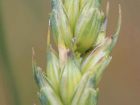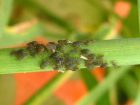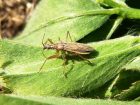
Features
Agronomy
Insect Pests
Fighting cereal aphids with your smartphone
Our enemy’s enemy is our friend. That’s the idea behind a calculator being developed to help Prairie cereal growers make decisions on whether to apply insecticides. In this case, our enemies are the various aphid species that infest cereal crops. If aphid populations are high during a sensitive crop stage, these delicate little insects can make a big dent in cereal yields. The aphids’ enemies include an array of insects that are able to chomp down, suck dry or otherwise destroy impressive numbers of aphids.
November 8, 2016 By Carolyn King
 A new tool will help growers to harness the pest control power of natural enemies like this seven spotted lady beetle larva that is stalking English grain aphids on a wheat head. Our enemy’s enemy is our friend. That’s the idea behind a calculator being developed to help Prairie cereal growers make decisions on whether to apply insecticides.
A new tool will help growers to harness the pest control power of natural enemies like this seven spotted lady beetle larva that is stalking English grain aphids on a wheat head. Our enemy’s enemy is our friend. That’s the idea behind a calculator being developed to help Prairie cereal growers make decisions on whether to apply insecticides.The tool includes the impacts of natural enemies in its calculations so it can better predict when spraying cereal aphids would be worthwhile economically.
Aphids reduce cereal yields by feeding on the plant’s sap and, depending on the aphid species, may also inject toxins into the plant or vector a plant pathogen called barley yellow dwarf virus. Also, aphids produce a sugary liquid known as honeydew that can promote fungal growth on the plant.
“Four main species of aphids attack cereal crops on the Prairies, but in the past few growing seasons the most common has been the English grain aphid, Sitobion avenae, with the oat-birdcherry aphid, Rhopalosiphum padi, the second most common. The greenbug aphid, Schizaphis graminum, is also present but at lower numbers,” says Tyler Wist, an entomologist with Agriculture and Agri-Food Canada (AAFC) in Saskatoon. He is leading the research to develop the calculator. He adds, “The fourth species is the corn leaf aphid, Rhopalosiphum maidis, but we really haven’t seen it in the last few years.”
John Gavloski, an entomologist with Manitoba Agriculture, is collaborating on the project. He says, “Neither the English grain aphid nor the oat-birdcherry aphid overwinters on the Prairies as far as we know; or if they do overwinter, they don’t do it very successfully.” Instead the aphids are blown in from the United States.
“The extent to which cereal aphids reduce yields depends on the crop stage when the aphid numbers get high, which also depends on when they blow in. Once the crop reaches the soft dough stage, aphid infestations have little effect on yields,” Gavloski notes.
The only insecticides registered for controlling aphids in cereals on the Prairies are malathion and dimethoate. Both insecticides belong to the organophosphate chemical group. Gavloski says, “Luckily, aphids are not an annual problem in cereals. If they were an annual problem, then we’d have big concerns over resistance management with two products in the same chemical group.”
These two insecticides kill not only aphids, but also a broad spectrum of other insects including many of the natural enemies of aphids. So it is especially important that growers know if the natural enemy populations are sufficient to stop the aphids from reaching damaging levels or if an insecticide application would make economic sense.
Data and discoveries
The research to develop the calculator is funded by the Pesticide Risk Reduction Program, a joint effort of AAFC and Health Canada’s Pest Management Regulatory Agency. In an initial two-year project, Wist developed a prototype calculator and conducted some initial testing of it. His current project, which runs from 2015 to 2018, is further refining and testing the calculator and working towards a mobile-friendly version for use by growers.
The calculator works by predicting the growth rate of aphid populations over a set period of time, usually one week, under the predation pressure of the natural enemies counted in a survey of an affected field. For accurate results, the calculations must be based on a detailed understanding of the aphids and their enemies in Prairie cereal fields.
“So far we’ve spent several seasons surveying the natural enemy and aphid populations in wheat, barley and oat fields [in Saskatchewan and Manitoba] to understand what species are out there and to see if changes in the aphid populations correlate to increased or decreased pressure from natural enemies,” Wist says. “This approach has been used previously for soybean aphids and their natural enemies in Ontario [in an app developed by Rebecca Hallett and her colleagues], and is adapted from an older series of equations that describes the interaction of aphid predators with their aphid prey. I made it work for cereal aphids and the natural enemies that we find on the Canadian Prairies.”
The calculator uses what is called a “dynamic action threshold” (DAT). “The conventional action threshold (CAT) is the aphid population level where insecticidal control is recommended to keep the aphid population from exceeding the economic threshold where the cost of controlling the aphids is less than the value of crop loss due to aphid feeding damage. The CAT doesn’t take into account the aphid population suppression by natural enemies,” Wist explains. “The DAT improves on the CAT by incorporating the number of aphids killed by natural enemies. Using a DAT instead of a CAT can reduce insecticide spraying and preserve any natural enemies that are present in the field.”
The main natural enemies of cereal aphids found by the project team over the past few years include lady beetles (adults and larvae), green lacewings (mostly larvae), damsel bugs and parasitoid wasps in the genus Aphidius.
Wist notes, “Lady beetles chew the aphids; a large lady beetle larva can eat around 75 larger-sized aphids per day. Green lacewing larvae and damsel bugs pierce the aphids and suck out their bodily fluids. Aphidius wasps lay their eggs into the aphids and their offspring eat the insides of the aphids and cause death around eight days after the egg was laid.” Bug enthusiasts can check out Wist’s YouTube videos showing some of the natural enemies in action (www.youtube.com/channel/UCGnNOA0VRVIBorl3UgLdXZA).
Gavloski says lady beetles and green lacewings are often seen in Manitoba cereal fields. A 1971 study of lady beetles in Manitoba found predation on aphids varied between species of lady beetles and species of aphids, with some lady beetle species eating over 100 aphids per day per individual. And green lacewing larvae are such good aphid predators that some people call them “aphid lions.”
Parasitoid wasps leave clear signs of their attacks on aphids. Gavloski explains, “After the aphid has died and the wasp has emerged, the aphid’s corpse is left behind; we call the corpse an ‘aphid mummy.’ Aphid mummies are usually bronze coloured, although some might be a bit darker, depending on the species of parasitoid. The mummy looks like an inflated, bronzy aphid.”
Wist and his team have made some discoveries that are helping to further improve the calculator’s accuracy. For instance, they’ve discovered the main parasitoid wasp species to be Aphidius avenaphis. They didn’t know how many aphids per day one of these wasps could kill, which is important for the tool’s calculations. So Wist conducted an experiment to answer that question.
He found an adult female Aphidius avenaphis kills 30 aphids per day on average. He also discovered that after the wasp larvae complete their development inside the aphids and emerge as adults from the mummies, they continue attacking aphids. A newly emerged female starts laying her eggs in aphids almost immediately after she emerges and mates, and she lays eggs for about five days.
Currently, Wist is continuing to refine the DAT equation with new data and information, making sure it matches the real world situation. He and his team are also continuing to take samples of the aphid and natural enemy populations in each field to ensure they haven’t missed any important species.
In the 2016 and 2017 field seasons, the project team is going to cereal fields with aphid populations that are just starting up, to assess the predictive ability of the calculator’s beta version. Wist notes, “The main challenge in this research comes from the migratory nature of the cereal aphids because I never know where or when the aphids will arrive. It’s difficult for me to cover the entire growing region and catch the aphid infestations when they start. [Next summer] if anybody sees aphids in their cereal fields, they can contact me (Tyler.Wist@canada.ca) and I’ll come out to take a look.”
As well, Wist and his team are now looking at turning the calculator into a web-based tool for field testing of the calculator and to see how it might work as a tool for growers. The provincial insect specialists from Alberta, Saskatchewan and Manitoba and some agronomists will be helping to test the web-based version. “After the web-based tool proves itself, we will look at rolling out mobile versions,” Wist says.
To use the tool, you would count the aphids on a set number of plant stems at several sites across a field, and input the data. You would also count the natural enemies on and around the sampled plants, and input that. The tool will have detailed photos so you can easily identify the aphids and their enemies.
The calculator takes all the input data and creates one number to describe the effect of all the natural enemies on the aphid population. Wist says, “The basic information that is then provided to the user will be either that the aphid population will not reach a damaging level and no action is warranted, or that the aphids could reach the economic threshold soon and cause yield loss so control might be warranted.”
A commonly used economic threshold for cereal aphids is about 10 to 15 aphids per stem of the plant. Users would be able to choose that threshold or change it to whatever level they wish.
Tips for now
Aphids are small but they tend to occur in clusters, or colonies, so they are fairly easy to see when you’re looking for them. Each species has its own preferences for colonizing a cereal plant. “English grain aphids tend to like the upper parts of the plant. They feed on the upper leaves and the heads. Oat-birdcherry aphids often colonize lower on the plant,” Gavloski says. Symptoms of cereal aphid attacks depend on which aphid species is attacking the plant.
For growers who are considering whether to spray for cereal aphid control, Gavloski has a series of recommendations.
First, figure out if you’re near or above the economic threshold of 10 to 15 aphids per stem. Check 20 stems in each of five areas in the field. Be sure to include some areas well into the field because plants along the field margins, especially near shelterbelts, may have high aphid numbers that are not representative of the whole field.
“If you are above the threshold, I usually suggest considering the crop stage. Once the crop gets to the soft dough stage, where the grain is starting to harden, the aphids won’t be an issue any more,” he says.
“I also suggest considering the natural enemies present in the field. If there is a lot of evidence of diseased aphids or predators or parasitoids, especially if you’re borderline threshold, that could help with your decision-making on whether to spray.”
Another factor to consider is whether the crop is drought-stressed. “A drought-stressed crop will have a much harder time recovering from aphid feeding than if growing conditions are good,” Gavloski explains.
He also suggests checking whether heavy rain is in the forecast. “After a really heavy rainstorm, aphid population numbers can go down significantly. In a heavy rain, the aphids get knocked from the plant. They are very delicate insects, so if they get knocked to the ground and water is pooling on the soil, you can get a lot of aphid kill.”
Wist hopes to have the DAT tool ready within the next couple of years. The tool will enable growers to make a much more accurate estimate of the impact of the natural enemies on the cereal aphid populations in fields. This should help reduce insecticide inputs and preserve insect friends, while maintaining crop yields.


